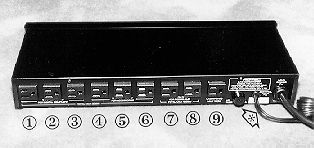Product Review -
Rotel RLC-900 Power Line Conditioner - December, 1995
By John E. Johnson, Jr.
![]()
 |
Rotel RLC-900 Power Line Conditioner; Eight-socket AC remote control line conditioner; Maximum total switching capability 15 amps; 20 amp fuse; Size 2"H x 17"W x 7"D; weight 2 pounds; $199; Rotel of America, 54 Concord Street, North Reading, MA 01864, Phone (508)-664-3820 or 800-370-3741, Fax (508)-664-4109
Power line conditioners are one of those things, like interconnects, vibration isolation pods, and so on, where controversy exists as to whether they make a difference in the sound quality. You can pay a lot of money for these items. The Rotel RLC-900 is a reasonably priced power line conditioner, and we decided to try one out.
The 900 has eight grounded (three holes) AC sockets for plugging in your equipment. Three are for digital components (sockets 1,2, and 3 in photo) like CD transports and DACs, three are for accessories (sockets 4,5, and 6 in photo) such as preamps and VCRs, and two are for power amplifiers (sockets 7 and 8 in photo). By use of remote control, you can power up the entire array of equipment plugged into the 900. You can use one of the remote control modules found at hardware stores, where you push a button on a remote control pad and power is supplied to the module (the module is plugged into the wall AC, and the remote control power cord - arrow in photo - is plugged into the module), or you can plug the remote control power cord into the switched outlet of a preamplifier. If you do not wish to use remote control, but rather simply use the on/off push-button on the front of the 900, there is one additional AC socket (socket 9 in photo) which is unswitched, and you just plug the remote control power cord in to it. Thus, the 900 is quite flexible.
There are a number of functions that a line conditioner can provide, including RF reduction, audio band noise suppression, and ground loop hum reduction. Radio frequencies (frequencies greater than 80 kHz) are present in all wires, whether they are connected to the electric company or not, because wires act like antennae. The radio frequencies interfere with audio frequency handling by your hi-fi gear and distort the signal. RF can be filtered with inductors, which serve as low pass circuits, or with ferrite. In the case of the 900, there is one ferrite choke at the AC input. Electrical noise in the audio band is generated not only by all the appliances in your home, but the appliances in your neighbors' homes as well, since they are on the same AC supply. This type of noise is reduced by the use of "hash" filters (induction-capacitance filters, or "LC" filters). The 900 has one LC filter for the three digital equipment sockets. Ground loop hum is usually caused when several components with three-pronged (grounded) AC plugs are in the hi-fi rig. You can get around this by removing the ground prong (sometimes dangerous, and occasionally not good operating procedure for particular components) or use of isolation transformers which don't allow the actual "earth" ground into the final circuit. There is one MOV (Metal Oxide Veristor) for spike protection in the 900. It will trigger at 150 volts with a reaction time of 50 nanoseconds (50 billionths of a second).
We found that the 900 did not make any difference in sound quality, with respect to removal of RF. This could be for several reasons: (1) it was improving the sound by filtering the RF, but we just could not hear the subtleties; (2) our AC lines for the test facility did not contain significant amounts of RF; (3) our components have good RF rejection to begin with; (4) any reduction in RF by the 900 was masked by RF which made its way into the equipment after the RLC-900. The 900 also did not remove the noise generated by variable intensity lamp switches. It may have reduced it, but not significantly so that we could hear a reduction. However, we did find that plugging all the equipment into the 900 reduced ground loop hum to practically inaudible levels. This was also interesting from the standpoint that the equipment consisted of a CD transport and DAC, two preamplifiers, one 250 watt rms/ch power amp, and one 300 watt rms/ch power amp. The 900 barely got warm after extended use.
There is one further aspect of this unit which is very important. When the 900 is powered up, sockets 1-6 (digital and accessory equipment) are turned on immediately, while sockets 7 and 8 (power amp sockets) are turned on 10 seconds later. When the 900 power is turned off, sockets 7 and 8 turn off immediately, and sockets 1-6 shut off 10 seconds later. Therefore, the power amps are the last to turn on, and the first to turn off. This eliminates transients generated by preamp power on/off that could damage speakers when passing through the power amplifiers.
The long and short of it is that the RLC-900 may or may not reduce RF interference, but we could not sense any sonic improvement. It does not appear to reduce audio band appliance noise significantly, but will help with ground loop hum if everything is plugged into it. Plus, it will handle lots of rather high powered components. However, in spite of these caveats, it is a great switching device for remote control power on/off of numerous pieces of equipment that might constitute your hi-fi setup, with delayed turn on/off of the various components, and therefore, we recommend it based simply on this feature.
John E. Johnson, Jr.
Editor-in-Chief
![]()
© Copyright 1995, 1996, 1997
Secrets of Home Theater & High Fidelity
Return to Table of Contents for this Issue.

